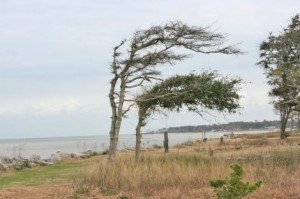“Mariah blows the stars around
And sends the clouds a’flyin’
Mariah makes the mountains sound
Like folks were up there dying”
We recently spent a weekend on Isle of Palms. When we hit the bridge over Cooper River on the Isle of Palms connector the wind hit us in the face and it blew every second of every day we were there. And it blew hard and steady, probably 15 to 20 m.p.h. on the marsh side of the island and 20 m.p.h. plus on the beach. The sand on the beach peppered you like a sand blaster, even kids gave up after 45 minutes or so.
On the marsh side, where we were staying, things weren’t so bad. We didn’t turn the air-conditioning on the whole time we were there – a couple of open windows and/or sliding doors and it was quite comfortable and the sound was soothing. The tall marsh grass waved and bowed before the determined zephyr and birds either spirited past riding the aiding tailwind or rowed vigorously into the crushing headwind.
We went out on the long dock to let the girls do some crabbing – a kind of blue crab catch and release program. At first the blustery embrace was refreshing and welcoming – the warm air pressing against your skin.
But it just never stopped and it made anything you were doing just a bit more difficult. You couldn’t simply lay the bag of crab bait on the dock – you had to be sure it was anchored down. Almost anything and everything had to be secured if you weren’t holding on to it. One bag got away, but luckily it stuck in the marsh grass not too far out. We sent Izzy out in the kayak to retrieve it. The ebbing tide and constant wind gave her a bit of a workout.
It’s easy to see why humans are so intent on finding effective efficient ways to harness the power of the wind. It is, indeed a force to be reckoned with.
When I worked offshore it wasn’t uncommon, especially in winter, to see lines of tugs with empty barges lashed together and tied to moorings in the Intracoastal Waterway. They were “wind bound” – meaning the wind made it too difficult for the tugs to maneuver the empty barges. I saw something quite similar on a trip to California in the early 90s – the gale force Santa Annas had miles of 18-wheelers parked (wind bound) along the Interstate.
In the simplest sense, wind is air moving from high pressure to lower pressure. In the case of small, strong short-lived systems like thunderstorms the flow of air can be direct from high to low pressure. However, for most large-scale weather patterns the flow is not direct. The rotation of the earth deflects the flow of air to the right in the Northern Hemisphere and to the left in the Southern Hemisphere, so the wind gets caught up in a circular motion, rotating around the high and/or low pressure areas. The closer the high and low-pressure systems are to each other the stronger the wind.
Like so much in nature, a little bit is a good thing, a light breeze to cool a sweltering summer afternoon or the rustle in the trees outside the bedroom window but too much of a good thing – like tornadic winds, hurricanes, etc. can be devastating. And like most impressive aspects of nature, wind can be inspiring:
“Wild Spirit, which art moving everywhere;
Destroyer and Preserver; hear, O hear!”
Percy Bysshe Shelley – “Ode to the West Wind.”
But the constant wind-blown second by wind-blown second from the other weekend left me thinking more along the lines of Catherine the Great, “A great wind is blowing, and that gives you either imagination or a headache.”

